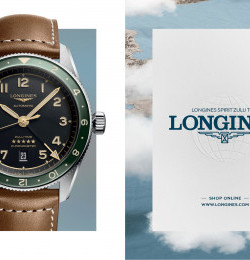

Longines
2610 St-Imier
Switzerland
About
founded by
Auguste Agassiz
belongs to
Swatch Group
about
In 1832, Auguste Agassiz entered the world of watchmaking by establishing a partnership with a watchmaking counter in Saint-Imier. Before long, he quickly took control of the enterprise and renamed it “Agassiz & compagnie”. At the time, the company assembled watches according to the “établissage” method, with people working at home, and developed trade links that enabled the company to sell its timepieces around the world, particularly in North America.
In the 1850s, Ernest Francillon, a nephew of Agassiz, took over the management of the reputed company and looked for ways to improve the traditional manufacturing methods used in local watchmaking. His idea was to group the different operations involved in the finalisation of timepieces together in one factory, where he would use mechanical production methods to assemble and finish complete watches. To bring this project to fruition, he purchased two adjoining plots of land on the right bank of the river Suze in the Saint-Imier valley in 1866. This area of land was called “Les Longines.” To help him develop the machines he needed to perfect the watchmaking processes, Ernest Francillon employed a young relative, an engineer named Jacques David.
The first in-house Longines movement was created in 1867. Francillon was the first watchmaker to introduce the winding crown. The same year Ernest Francillon returned from the World's Fair in Paris with a bronze medal for this watch. In the 1870s, the industrial approach that Francillon had chosen proved highly successful and the factory continued to grow until the first third of the 20th century. By 1911, the Longines factory employed more than 1,100 people and its watches were being distributed around the world.
Longines gradually built a special relationship with the world of sport. Present in Athens in 1896, the company has been closely associated with the worldwide development of sport, timing Olympic Games fourteen times, beginning with Oslo in 1952. Its partnership drove the company to devise a variety of inventions and developments enabling it to determine and display winning times.
After the great success of wristwatches at the beginning of the 20th century, the Longines factory underwent a massive reorganization of methods of production during the 1920s and 30s. In 1912 Longines began a close partnership with gymnastics as the official timekeeper for the 1912 Swiss Federal Gymnastics Meet in Basel. The result of this partnership was the introduction of automatic timing. In 1912 at the Swiss Federal Gymnastics Meet, it introduced the “broken wire” automatic timing system.
Despite these strong links with sport, the company does not confine itself to timing competitive events. Since 1919, it has been the official supplier to the FAI, the World Air Sports Federation, and has provided the aeronautical world with the timing equipment required to verify several world records. Among them was the historic human and technical achievement of the American pilot, Charles Lindbergh, who, in 1927, made the first non-stop solo crossing of the North Atlantic in his vessel named “Spirit of St Louis”. Longines instruments have thus accompanied many explorers on journeys around the planet and have supported the pioneers of the sky.
In 1952, its Photogines was the first device to visualize the finish line as it measured times. By 1960, the Contifort combined moving images and timing functions. These and other inventive developments contributed to Longines’ sporting credentials. Longines started equestrian timekeeping in 1926 at the Concours Hippique International in Geneva. It has since then officiated at more than one hundred national and international show-jumping competitions in Europe and in North America, providing timing services at competitions including World Championships, European Championships, and Olympic Games along with many CSIO meets as well as, more recently, Arab League competitions.
Longines started in skiing in 1933, and returned to it in 2006, becoming official timekeeper for the FIS’s 2006-2007 Alpine World Cup competitions.
In addition to the Olympic Games, Longines has timed 31 Tours de France.
Longines' mastery of advanced technologies moved it also to approach Formula One racing, an experience that ultimately led to a partnership with Ferrari of Italy.
In the 1970s Longines experienced a breakthrough in development and production. In 1972, Longines was the first world watch maker to introduce a LCD-display watch on the consumer market. There were advances in performance of the watches and their appearance continued to change. In 1980s there were a series of ultra-thin designs following another world record of Longines in 1979 - the thinnest quartz watch called the Feuille d'Or - it was just 0.98 mm thick.
Longines is a member of the Swatch Group, the world’s leading producer of watches and associated products. Today, the company is present in more than 130 countries and has preserved its essential, long-standing values.
The Look
Longines’ signature is timeless elegance based on a rich aesthetic heritage that it keeps up-to-date with a skilful blend of refinement and classicism. Its current models are inspired by a history of daring technology and bold styling nurtured within the Manufacture, a huge laboratory that carefully protects the profile of Longines creations.
Today, Longines creates timepieces that are adapted to the constraints of modern times without sacrificing its core values. The watchmaking tradition of the winged-hourglass brand is exemplified by models in the Longines Master Collection, the Longines Evidenza, Longines Spirit, or the Heritage Collection (Flagship Heritage, Longines Clous de Paris, Conquest Heritage, or Les Elégantes de Longines). Its devotion to elegance is expressed in the Longines Dolce Vita, Longines BelleArti (contemporary elegance) or La Grande Classique de Longines (classic elegance) collections. Finally, all of its sporting experience is invested in performance, with models such as the HydroConquest, Conquest, GrandVitesse and Longines Admiral. The Longines Sport Legends (The Longines Weems Second-Setting Watch, the Lindbergh Hour Angle Watch, the Longines Legend Diver and the Longines Istituto Idrografico R. Marina Watch) all pay tribute to the famous instruments that have been invented by the brand with the winged hourglass.
Who Wears It
Kate Winslet, Ingeborga Dapkunaite, Stefanie Graf, Denise Keller, Chi Ling Lin, Aishwarya Rai Bachchan, Andre Agassi, Aaron Kwok Fu Shing, Peter Lohmeyer, Oleg Menshikov,

